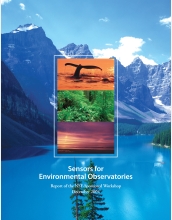|

Press Release 06-010
NSF Releases "Sensors for Environmental Observatories" Report

Devices will enable a deeper and broader understanding of Earth's environment
January 17, 2006
Humidity sensors monitor fire danger in remote areas. Nitrate sensors detect agricultural runoff in rivers and streams. Seismic monitors provide early warnings of earthquakes.
"In situ," or in place, sensors are producing a revolution in our understanding of the environment, according to the new National Science Foundation (NSF) report, Sensors for Environmental Observatories. Sensors, the report states, will enable a deeper and broader understanding of Earth's environment. Better-informed public policies that address the interactions between human society and the natural environment will be the result.
Environmental scientists, with the support of NSF and other agencies, have in recent years designed and begun to implement several new environmental observing systems, including EarthScope, the National Ecological Observatory Network (NEON), the Ocean Observatories Initiative (OOI), and others.
"These efforts will enable much-needed longer-term sensing of the environment," said Margaret Leinen, NSF assistant director for geosciences. "However, there are significant limitations to current sensor technology and the networks that collect data from them."
To track changing conditions in deserts, forests, oceans or the atmosphere, environmental sensors must, like the postman, deliver information through snow, sleet, rain, and dark of night.
To address these needs, scientists affiliated with universities, research laboratories, education and outreach activities, international activities, federal agencies and industry participated in a workshop: Sensors for Environmental Observatories--A Framework for Progress. Attendees focused on identifying opportunities for enhancing existing sensors and sensor networks, and on ways of filling current knowledge gaps in sensor technology.
"Environmental science is at a crossroads," said scientist Peter Arzberger of the University of California at San Diego and lead organizer of the NSF workshop. "We're in a new era that increasingly relies on sensors and sensor networks."
To better understand the intricacies of Earth's environment, according to the workshop report, scientists need to develop new types of sensors, link sensors in a broader network, foster coordination across various types of environmental observatories in which sensors are placed, and develop sensors with long-term autonomous deployment and maintenance.
The report highlights key observations, findings and recommendations:
- A national commitment is needed to sensor development, and to research and design coordination of sensor networks.
- Challenges ahead are beyond the experiences of individual scientists and institutions and agencies. New partnerships need to be developed among scientists and engineers involved in environmental research.
- New modeling and visualization tools are critical for the development of sensor networks.
- Sensor technologies need to be further developed to measure a wider variety of parameters, with emphasis on biology and chemistry, as these fields lag behind sensors that measure physical parameters.
- Sensors should be developed in the context of a linked sensor network, available cyberinfrastructure, and the environment in which they are placed.
-NSF-

Media Contacts
Cheryl Dybas, NSF (703) 292-7734 cdybas@nsf.gov
Related Websites
"Sensors for Environmental Observatories" Report: http://wtec.org/seo/final

The National Science Foundation (NSF) is an independent federal agency that supports fundamental research and education across all fields of science and engineering. In fiscal year (FY) 2009, its budget is $9.5 billion, which includes $3.0 billion provided through the American Recovery and Reinvestment Act. NSF funds reach all 50 states through grants to over 1,900 universities and institutions. Each year, NSF receives about 44,400 competitive requests for funding, and makes over 11,500 new funding awards. NSF also awards over $400 million in professional and service contracts yearly.
 Get News Updates by Email Get News Updates by Email
Useful NSF Web Sites:
NSF Home Page: http://www.nsf.gov
NSF News: http://www.nsf.gov/news/
For the News Media: http://www.nsf.gov/news/newsroom.jsp
Science and Engineering Statistics: http://www.nsf.gov/statistics/
Awards Searches: http://www.nsf.gov/awardsearch/
| 

